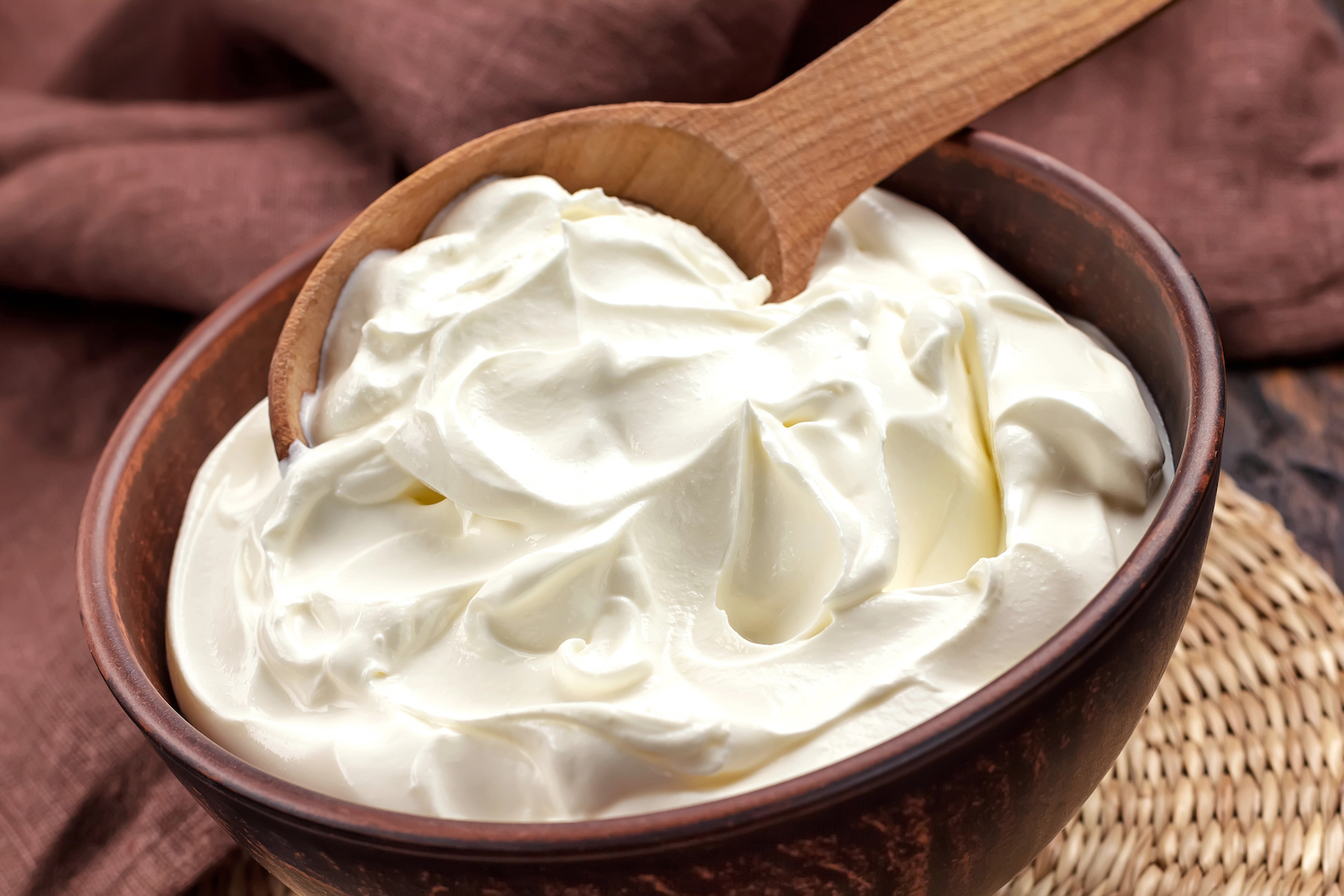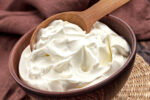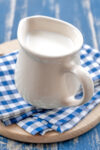
The Wonderful Flavor of Cream
In the 1800s, milk products were not pasteurized, so cream was created by letting it rise from whole milk at room temperature. If you didn’t raise your own dairy cow, you could obtain cream by letting it rise from milk delivered by the milkman. But with no electrical refrigeration, cream didn’t remain fresh for long, so it was a luxury.
Today we can buy refrigerated milk and cream at grocery stores and because they are pasteurized, they last much longer. At the bottom of the page are links to articles on pasteurization, how to separate cream from pasteurized milk, and how to make clotted cream (modern method).
INFORMATION BELOW COMPILED FROM 1800s COOKBOOKS
CREAM
The particles of fat that rise to the top of milk when it is allowed to remain undisturbed for some time is known as cream. Cream may be removed from the milk by skimming it off, or it may be separated from the milk by means of machinery especially designed for the purpose. The greater the proportion of fat in milk, the thicker, or “heavier,” will be the cream.
Various grades of separated cream are placed on the market, the usual ones being those which contain 8, 12, 16, 20, and 40 per cent of fat.
Medium-heavy cream is the kind to select when it is desired for whipping. This is a process that consists in beating the cream rapidly until a mass of tiny bubbles form and become stiff, very much as the white of egg does.
Cream from milk that has stood twenty-four hours is known as double cream. This cream, when chilled, may be beaten stiff with the Dover egg-beater* in a very few seconds. This gives a firm, fine-grained cream and is used whenever a rich, stiff cream is required; such as an addition to a salad dressing, for the filling of cream cakes and éclairs, or to force through a pastry-bag and tube for a garnish. When it is used to give lightness, as in Bavarian cream, etc., it should be folded, not stirred, into the other ingredients.
*Dover egg beater – a hand operated rotary egg beater patented by the Dover company in 1873.
SEPARATION OF MILK AND CREAM.
If it be desired that the milk should be freed entirely from cream, it should be poured into a very shallow broad pan or dish, not more than one and one-half inch deep, as cream cannot rise through a great depth of milk. Milk should be shaken as little as possible when carried from the cow to the dairy, and should be poured into the pans very gently.
Persons not keeping cows may always have a little cream, provided the milk they purchase be pure and unadulterated. As soon as it comes in, it should be poured into very shallow open pie-dishes and set by in a very cool place. In seven or eight hours, a nice cream should have risen to the surface.
DAIRY SECRET FOR INCREASING THE QUANTITY OF CREAM
Have two pans ready in boiling hot water and when the new milk is brought in, put it into one of these hot pans and cover it with the other. The quality as well as the thickness of the cream is improved.
RICH CREAM FOR TEA OR COFFEE
Put some new milk into an earthen pan, heat it over the fire, and set it by till the next day. In order to preserve it a day or two longer, it must be scalded*, sweetened with lump sugar, and set in a cool place.
When the sweetness of the cream is doubtful and there is no more on hand and it must be used, a pinch of soda will keep it from curdling, even in hot coffee.
*scald – to heat liquid almost to a boil, until bubbles begin to form around the edge.
BURNT CREAM
Boil a pint of cream with a stick of cinnamon and some lemon peel. Take it off the fire and pour it very slowly into the yolks of four eggs, stirring it till half cold. Sweeten it, take out the spice, and pour it into a dish. When cold, strew* over it some white pounded sugar, and brown it with a salamander.*
*strew – to scatter or spread untidily over a surface or area.
*salamander – a circular iron plate to which a long handle is attached. It is made red hot in the fire and held over the article to be browned, being careful not to have it touch.
HOUSEWIFE’S CREAM
Take one-half a pint of good cream, one-fourth pint white wine, one teacup powdered white sugar, and the rind and juice of one lemon. Put all into a large basin, and whisk till it becomes quite thick, then put into glasses and let them remain in a cool place till required. [This cream is better if made the day before it is wanted, and it will keep good for several days if the weather is not too warm.]
CLOTTED or CLOUTED CREAM
(also known as DEVONSHIRE CREAM)
Let milk stand undisturbed in a cool, well ventilated place for twelve hours in summer, and twenty-four in winter. Then set the pan carefully in some place over the fire where it will heat very slowly almost to the boiling point; but it must not boil. (It is better to set the pan in water which will come up on the sides as high as the milk.)
As soon as the cream forms a ring in the middle, remove a little with the finger, and if a few bubbles rise in the place where you do so, it is done, which will be in half to three-quarters of an hour. Remove it from the fire, and let it remain twenty-four hours. Then skim it and throw a little sugar on the top.
The cream should be a compact mass of considerable thickness, and may be divided with a knife into squares of convenient size before skimming. This is a most delightful substitute for butter on bread, and it may also be used with cereals and fruits.
SNOW CREAM
Take the richest cream you can procure, season it with a few drops of essence of lemon, or syrup of lemon peel, and powdered white sugar, and if you choose, a spoon of preserve syrup. Just as you send it to table, stir in light newly fallen snow till it is nearly as stiff as ice cream.
SYRUP OF CREAM
Scald a pint of perfectly fresh cream, add to it one and one-fourth pound of powdered lump sugar. Keep it in a cool place for two or three hours, then put it into small phials holding one or two ounces each, and cork it close. It will keep good thus for several weeks, and will be found very useful in voyages.
FRIED CREAM
Take one pint milk, one-half cup sugar, the yolks of three eggs, two tablespoons corn-starch and one of flour mixed, one-half teaspoon vanilla, two inches of stick-cinnamon, and one teaspoon butter.
Boil the cinnamon in the milk. Stir the corn-starch and flour smooth in a little cold milk or water, and add to the milk. Beat the yolks light with the sugar, and add. Take from the fire, take out the cinnamon, and stir in the butter and vanilla. Pour out on a buttered tin or dish, letting it be about half an inch thick. When cold and stiff, cut into pieces about three inches long and two wide. Dip carefully in sifted cracker-crumbs, then in a beaten egg, in crumbs again, and fry like croquettes. Dry in the oven four or five minutes, and serve at once. Very delicious.
NOTE: Although the above recipe calls for milk rather than cream, it’s called “fried cream” and sounded so interesting, I included it. ~~ Angela
MOCK CREAM
Heat a pint of fresh, unskimmed milk in a double boiler. Stir in two tablespoons of sugar and two tablespoons of cornstarch which has first been rubbed smooth in a very little cold milk. Bring just to a boil, stirring constantly; then pour the hot mixture, a little at a time, beating thoroughly all the while, over the well-beaten white of one egg. Put again into the double boiler, return to the fire, and stir till it thickens to the consistency of cream.
=================================================
FURTHER READING:
The History of Milk that Led to Pasteurization
How to Separate Cream from Pasteurized MIlk
=================================================
Do You Have Any Special Ways You Use Cream? Please Leave a Comment Below.
=================================================

